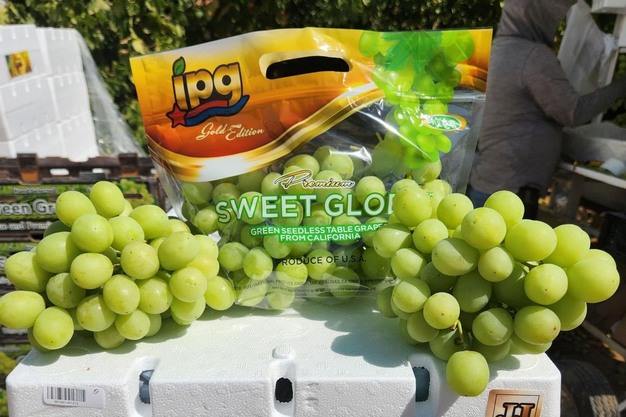"The 2025 California table grape season is shaping up to be one of the most dynamic in recent years," says Dalton Dovolis with International Produce Group (IPG). "Both challenges and opportunities present themselves, but across domestic and global markets one theme is clear: quality is driving business and there is a place for premium fruit."
Export demand highlights quality
On the export side, demand throughout Asia has been strong, especially for premium fruit. Vietnam, Cambodia, Singapore, Malaysia, and Taiwan have all shown increased interest in top-end grapes. Demand from Hong Kong on the other hand has been somewhat softer. It is concentrated on high-performing varieties like Sweet Globe™, Autumncrisp®, and Applause™ (Sugra 54). "On a positive note, the Hong Kong market has started to show more buying power in the past week." Japan has also been quiet but typically demand builds up in October.
Within this landscape, IPG's business to Asia is up quite a bit this year, with growth across the board. By focusing heavily on the most premium grapes — what the company calls 'luxury grapes' — available across growing regions and curating the best packs, IPG has seen strong demand and results well above last year.
 © IPG
© IPG
Dalton Dovolis inspecting and showing green table grapes.
Competition from local Asia production
However, not all markets have been open to U.S. grapes. Thailand, Indonesia, and the Philippines remain flooded with lower-priced grapes from China, limiting opportunities for U.S. suppliers. Nevertheless, there are positive signs as Bangkok has recently started buying high-end green seedless grapes, signaling what could be a strong September – December run.
Korea has been a different story. Earlier in the season, the country's robust Shine Muscat crop sharply reduced California imports. Over the past week, though, activity has begun to pick up again. The market is currently less focused on greens and more interested in reds and blacks, given that domestic Muscat production already covers their green grape needs.
"One constant holds true across all markets: the very best fruit always finds a home," Dovolis added.
Pricing gap
Quality is becoming increasingly important and as a result, the price gap between commodity fruit and premium fruit is growing. "This is one of the defining trends this year," said Dovolis. "The rewards have been clear for growers and marketers delivering the right flavor, crunch, and presentation." Within the green grape category, Ivory™, Sweet Globe™, Great Green™, and Autumncrisp® are leading the charge. Within the red segment, Krissy™, Jack's Salute™, Ruby Rush®, Sweet Scarlet, and a handful of specialty red seedless varieties have all found their place — provided the quality matches.
 © IPG
© IPG
Domestic market under pressure
The U.S. domestic market has been especially tough this season. The terminal wholesale markets are struggling, with heavy volumes of Mexican fruit in the system creating backups and suppressing pricing. On top of this, a lingering cherry season hangover kept competing fruit on retail shelves longer than usual, slowing movement in the grape category just as California volume came on.
Many growers who rely on terminal markets are finding it difficult to move fruit or are forced to take reduced returns. Programs with retailers are holding up better, but volumes are not where growers would like. Because of the weak market, cold storage facilities are at capacity, to the point that some growers cannot even pick as much as they would like — there is simply nowhere to put the fruit.
Growers and marketers with strong programs are doing "fine," though far from exceptional, while those dependent on the open market are taking a beating. Above all, however, good fruit is still moving. High-quality lots continue to find homes, while weaker fruit lingers. This imbalance has also made many growers more eager to build export opportunities and increase their reliance on international programs.
 © IPG
© IPG
Looking ahead
While the landscape of table grapes can be illustrated by oversupply, global competition, and shifting demand patterns, the momentum around premium grapes is a positive signal. "I expect premium positioning to expand across categories; from berries to citrus to stone fruit. The future of fresh produce is premium."
In California, growers have once again shown they can deliver fruit that competes on the world stage. The state's harvest is running about one to two weeks ahead of last year. While that doesn't necessarily mean an early finish, the best fruit is expected to clear quickly, with carryover likely lingering into the import window. "We are now transitioning into the late-season greens, including jumbo Autumn King and flavorful Autumncrisp®, alongside a strong finish in reds and blacks."
A big thing to watch will be how quickly cold storage space frees up, whether terminal markets can recover, and how demand holds into the back end of the season. Weather also remains a concern, as late-season rains could affect some of the final crops and have already impacted certain northern regions. At the same time, preparations are underway for what is expected to be an even bigger Peruvian and Chilean import season, keeping the focus on premium fruit year-round. With strong sourcing networks in California, Peru, and Chile, IPG is positioned to keep premium fruit flowing year-round — ensuring continuity for global partners. And in the end, one truth sums up the season best: premium fruit always has a home.
 For more information:
For more information:
Dalton Dovolis
International Produce Group (IPG)
Tel: (+1) 831-754-9740
[email protected]
www.internationalproducegroup.com
